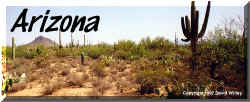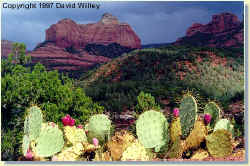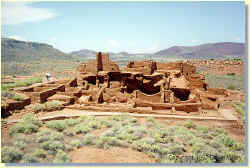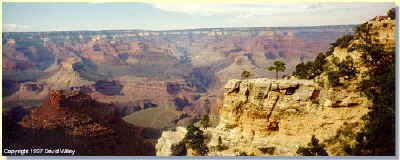 The Willey Travel Guide: Arizona (Part 1) - North to the Grand Canyon Written by David and Christopher It's August 1997 and Ottawa is in the midst of a four week drought. But it was obviously neither hot enough nor dry enough for us because we packed our bags and SPF 30 sunscreen and spent seven days travelling from one end of Arizona to the other. When people think of Arizona, the first thought is that it is just one big desert with loads of cacti, scorpions and other such creatures. What could be of interest in a state where the tide never comes in. But the American south-west had always fascinated us, me particularly. Of the areas in the United States that I most wanted to visit, this was it. Not only did we want to experience the desert climate first-hand (it must be a Canadian thing), but Christopher and I are both interested in native american culture and the south-west, particularly Arizona, is an area with a large native american influence.
For a start, Arizona consists of three zones or ecosystems, so to speak. There are a series of mountains that run from the northwest to the southeast of the state. In these mountains we find a more northern ecosystem with evergreen trees, cooler weather and in the winter, snow. North of the mountains are the canyon lands, including the "big one", the Grand Canyon. To the south is the Valley of the Sun and northern reach of the Sonoran Desert. Here we find the saguarro and other cacti. We actually passed through all three zones in one day starting at the Petrified Forest and the Painted Desert of the north, passing through the mountain passes in the Apache nation and finally reaching the Sonoran Desert at Tucson. Getting there was easy now that Air Canada has direct flights from Toronto. As usual the service on the flights to and from Phoenix were first-rate and included being served by a flight attendant who was the spitting image of Ontario's Premier, Mike Harris. And yes, he has been told this...many, many, many times! Our normal approach to touring vacations is to choose a base location from which we make a series of day trips. This trip was no exception. We decided to stay in bed and breakfasts, since in Ontario we have always found that farm B&B's are an excellent and inexpensive form of accommodation (for more information on Ontario farm vacations contact the Ontario Farm & Country Accommodations, RR2 Alma, Ontario, Canada N0B 1A0 (519) 846-9788). What was surprising in Arizona was that B&B accommodation was more expensive than the small hotel/motel chains, costing in the neighbourhood of $65 US per night double. We headed north via Prescott, Jerome, Sedona and the Oak Creek Canyon area. The scenery was breathtaking particularly the colours...the blue sky backdropped against the red hills. While the narrow, winding roads leading into Jerome were stomach crunching, the view from this village perched on a mountain pass more than made up for it. Once a mining town, Jerome has now become an artist community. It must be the inspiration. The Oak Creek Canyon gave us the first indication that Arizona is not just desert. The scenery here could have been in Algonquin Provincial Park back in Ontario. We finally arrived in Williams, which would serve as our northern base, staying in a charming Victorian home known as the Johnstonian B&B (520 635-2178). The home was filled with antiques and our host, Pidge Johnston, treated us royally. Williams is located next to the I-40 with its main street forming part of the old Route 66. It is about one hour from the Grand Canyon and is the home of the Grand Canyon Railway. Unfortunately, despite the friendliness of its citizens, the town is in dire need of a major overhaul. We found that there was little to offer the visitor. After a wonderful breakfast we headed north towards the Grand Canyon. A short drive north of Flagstaff we visited the Sunset Crater National Monument. This is an extinct volcano that last erupted in the 1200's. You can no longer hike on Sunset Crater due to the damage it causes but we took advantage of the walking trails of the nearby Lenox Crater. It is interesting to see that, while there is "life in them thar' hills", it is somewhat sparse compared to the non-volcanic areas. The Bonito Lava Flow trail gave us a first-hand look at lava and provided a rough, black contrast to the red of the craters.
Built by the Sinagua (meaning without water) and Anasazi tribes around 1100 AD, the Wupatki Pueblo provided a home to the tribes after the eruption of Sunset Crater Volcano forced them from their old farmlands. The Pueblo is right next to the Visitor Centre and has a self-guided trail. The site is well maintained and well worth the visit. Christopher was fascinated by the blow hole, which is the opening for a series of underground cracks that act like a natural barometer. Changes in air pressure cause air to either rush in or out. Continuing north on Route 89 we entered the Navajo nation (which remains on Standard Time throughout the year). The scenery here is desolate but striking with a strong contrast of reds and blues. We often thought how much this reminded us of the photos of Mars recently taken on the Pathfinder mission. There was little in terms of settlements. At the Cameron crossroads there was a trading post where you could purchase Navajo rugs and other artifacts. Most of the contact with the Navajo people took place at the many roadside souvenir stands. Here you find people selling "typical handmade Navajo" pottery, jewellery and rugs. Since the merchandise looks the same from table to table one realizes how "handmade" the goods likely are. However, as relatively inexpensive momentos of your trip, they are fine. Don't forget to bargain. Nothing really prepares you for the Grand Canyon. Entering via the Eastern entrance you slowly head towards the village stopping at the various lookouts, starting with Desert View. The views are breathtaking and photos cannot really do the Canyon justice. For an 11 year old boy to be awed by the sight of a hole in the ground, you realize how spectacular it must be.
At the Village you are required to park and take a shuttle bus to visit the West Rim. You can also walk the West Rim Trail but be careful since there are few fences on the trail. The view above was taken from the West Rim Trail. Because of its location, Hopi Point provides visitors with one of the best views of the Canyon. Sunset is supposed to be particularly memorable. We were unfortunately unable to witness this first hand since we wanted to make the last showing of the IMAX film Grand Canyon: The Hidden Secrets. The film is excellent and tells the story of the Canyon. You quickly realize that a visit to the canyon floor would be well worth the effort...perhaps on the next trip. The next day presented us with a dilemma - do we make the 9 to 10 hour return trip to Monument Valley or do we do something else. We decided to go to Page and visit the Glen Canyon Dam. The Dam and the tour were interesting but were not worth the time it took to get there (7 hours return). Thursday was our version of the longest day. We were heading south for Tucson and our new base of operations. However, rather than take the direct interstate route, we were taking the long route. Continued on the next page.
|
 As we researched our trip, we were surprised to
find that Arizona is blessed with many natural wonders, much more than just a desert, and
is home to a number of native nations including the Navajo, the Hopi, the Apache and the
Tohono O'otam.
As we researched our trip, we were surprised to
find that Arizona is blessed with many natural wonders, much more than just a desert, and
is home to a number of native nations including the Navajo, the Hopi, the Apache and the
Tohono O'otam. Continuing north from Sunset Crater we
left the mountains, and the cooler climate, behind and descended into the western reaches
of the Painted Desert. Twenty-five minutes later, a red structure appears to rise
majestically from the earth, contrasting spectacularly against the blue sky. This is
the Wupatki National Monument, shown at left.
Continuing north from Sunset Crater we
left the mountains, and the cooler climate, behind and descended into the western reaches
of the Painted Desert. Twenty-five minutes later, a red structure appears to rise
majestically from the earth, contrasting spectacularly against the blue sky. This is
the Wupatki National Monument, shown at left.